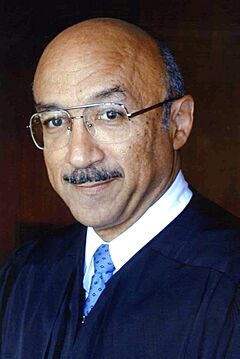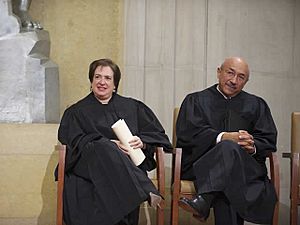Harry T. Edwards facts for kids
Quick facts for kids
Harry T. Edwards
|
|
|---|---|

Official portrait, 2013
|
|
| Senior Judge of the United States Court of Appeals for the District of Columbia Circuit | |
| Assumed office November 3, 2005 |
|
| Chief Judge of the United States Court of Appeals for the District of Columbia Circuit | |
| In office September 19, 1994 – July 16, 2001 |
|
| Preceded by | Abner Mikva |
| Succeeded by | Douglas H. Ginsburg |
| Judge of the United States Court of Appeals for the District of Columbia Circuit | |
| In office February 20, 1980 – November 3, 2005 |
|
| Appointed by | Jimmy Carter |
| Preceded by | David L. Bazelon |
| Succeeded by | Seat abolished |
| Personal details | |
| Born |
Harry Thomas Edwards
November 3, 1940 New York City, U.S. |
| Spouse |
Pamela Carrington
(m. 2000) |
| Children | 2 |
| Education | Cornell University (BS) University of Michigan (JD) |
Harry Thomas Edwards (born November 3, 1940) is an American lawyer and judge. He serves as a senior judge on the United States Court of Appeals for the District of Columbia Circuit. This court is very important because it handles many cases involving the U.S. government. Judge Edwards is also a law professor at New York University School of Law.
President Jimmy Carter appointed Judge Edwards to the D.C. Circuit in 1980. He was the chief judge of the court from 1994 to 2001. In 2005, he became a senior judge, which means he can still work but with a reduced caseload.
Contents
Early Life and Education
Growing Up in New York
Harry Thomas Edwards was born in New York City on November 3, 1940. He was the oldest of three children. His parents divorced in 1950, and his mother raised him and his two sisters.
When his mother went to college for her Master's degree, Harry lived with his grandparents in Harlem, New York. Later, his family moved to Long Island. Harry went to Uniondale High School and was the president of his graduating class.
College and Law School
Harry Edwards earned a Bachelor of Science degree from Cornell University in 1962. He then went to the University of Michigan Law School, where he earned his law degree (called a Juris Doctor) in 1965. He did very well in law school.
When he graduated, Harry Edwards was the only African American law student or teacher at the University of Michigan Law School. During his time in Michigan, he spent time with his father and stepmother, Esther Gordy Edwards. His stepmother was a senior leader at Motown Record Company, founded by Berry Gordy, Jr.
Professional Career: 1965–1980
Starting His Legal Journey
Even though Harry Edwards had excellent grades in law school, he faced challenges finding a job. Many law firms openly turned him down because he was Black. With help from his mentor, Professor Russell Smith, he finally got a job at a law firm in Chicago.
From 1965 to 1970, he worked there, focusing on labor law. This area of law deals with the rights of workers and unions. He also worked on collective bargaining, which is when workers negotiate with their employers.
Becoming a Law Professor
In 1970, Harry Edwards joined the faculty at the University of Michigan Law School. He was the first African American to teach there. He taught about labor law, workers' rights, and how to resolve disagreements.
He also taught at Harvard Law School for a time. In 1977, President Carter asked him to join the Board of Directors for Amtrak, a national passenger rail company. He later became the Chairman of the Board.
Federal Judicial Service
Joining the D.C. Circuit Court
In 1977, President Carter wanted to make the federal courts more diverse. At that time, there were very few women or Black judges. President Carter created special groups to find talented lawyers from diverse backgrounds to become judges.
In 1979, Harry Edwards was one of the lawyers recommended for a position on the United States Court of Appeals for the District of Columbia Circuit. This court is one of the most important federal appeals courts in the country. President Carter nominated him, and the United States Senate approved his appointment.
Harry Edwards became a judge on February 20, 1980. He was 39 years old, making him one of the youngest federal appeals court judges at that time.
Leading the Court
Judge Edwards served as the chief judge of the D.C. Circuit from 1994 to 2001. During his time as chief judge, he made many improvements to the court. He helped organize the court's offices and improved how cases were managed. This helped the court handle cases faster and reduce backlogs.
He also helped get support for building an addition to the courthouse. Judge Edwards was praised for helping the judges on the court work well together. On November 3, 2005, he became a senior judge.
Law Teaching and Scholarship Since 1980
Continuing to Teach and Write
Since 1980, Judge Edwards has taught at many law schools, including Duke, Georgetown, and Harvard. He is currently a professor of law at NYU School of Law, where he has taught since 1990.
He has also written several books about law. One of his important articles, written in 1992, discussed the connection between legal education and the legal profession. This article has been widely discussed by legal experts.
Understanding Judicial Decisions
Judge Edwards has also written about how appeals court judges make decisions. He explains that most decisions made by the U.S. Courts of Appeals are unanimous, meaning all judges agree. He believes that judges' personal beliefs are not the main reason for their decisions.
He points out that the U.S. Courts of Appeals are different from the U.S. Supreme Court. The Supreme Court often has more disagreements among its judges.
Work with the National Academy of Sciences
Improving Forensic Science
In 2006, Judge Edwards was asked to help lead a committee at the National Academy of Sciences. This committee studied the needs of the forensic science community. Forensic science uses scientific methods to solve crimes.
In 2009, the committee published an important report. It said that there were serious problems in the nation's forensic science system. The report called for better training, standards, and research for forensic scientists. It also noted that many labs needed more funding and oversight. This report led to many efforts to improve forensic science.
Judge Edwards continued to work on improving forensic science. He served on other committees and wrote papers about the need for reform. In 2019, he received an award for his work in supporting criminal justice reform and preventing wrongful convictions.
Professional Activities

Judge Edwards is a member of the American Academy of Arts and Sciences. He is also on the Board of Directors for the Institute for Judicial Administration at NYU School of Law.
He has received many awards for his work. In 2004, he received the Robert J. Kutak Award for his high standards in the legal profession. In 2011, he received the first Distinguished Alumni Award from the University of Michigan Law School. He has also received honorary degrees from various universities.
Personal Life
Harry Edwards married Pamela Carrington-Edwards in 2000. Justice Ruth Bader Ginsburg officiated their wedding ceremony. He has a son named Brent, who is a professor at Columbia University, and a daughter named Michelle. He also has four grandchildren.
See also
- List of African-American federal judges
- List of African-American jurists
- List of United States federal judges by longevity of service

